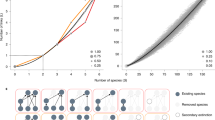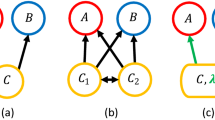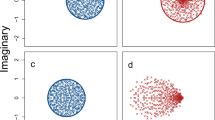Abstract
Forty years ago, May proved1,2 that sufficiently large or complex ecological networks have a probability of persisting that is close to zero, contrary to previous expectations3,4,5. May analysed large networks in which species interact at random1,2,6. However, in natural systems pairs of species have well-defined interactions (for example predator–prey, mutualistic or competitive). Here we extend May’s results to these relationships and find remarkable differences between predator–prey interactions, which are stabilizing, and mutualistic and competitive interactions, which are destabilizing. We provide analytic stability criteria for all cases. We use the criteria to prove that, counterintuitively, the probability of stability for predator–prey networks decreases when a realistic food web structure is imposed7,8 or if there is a large preponderance of weak interactions9,10. Similarly, stability is negatively affected by nestedness11,12,13,14 in bipartite mutualistic networks. These results are found by separating the contribution of network structure and interaction strengths to stability. Stable predator–prey networks can be arbitrarily large and complex, provided that predator–prey pairs are tightly coupled. The stability criteria are widely applicable, because they hold for any system of differential equations.
This is a preview of subscription content, access via your institution
Access options
Subscribe to this journal
Receive 51 print issues and online access
$199.00 per year
only $3.90 per issue
Buy this article
- Purchase on Springer Link
- Instant access to full article PDF
Prices may be subject to local taxes which are calculated during checkout



Similar content being viewed by others
References
May, R. M. Will a large complex system be stable? Nature 238, 413–414 (1972)
May, R. M. Stability and Complexity in Model Ecosystems (Princeton Univ. Press, 2001)
MacArthur, R. Fluctuations of animal populations and a measure of community stability. Ecology 36, 533–536 (1955)
Elton, C. S. Animal Ecology (Univ. of Chicago Press, 2001)
McCann, K. S. The diversity–stability debate. Nature 405, 228–233 (2000)
Levins, R. Evolution in Changing Environments: Some Theoretical Explorations (Princeton Univ. Press, 1968)
McNaughton, S. J. Stability and diversity of ecological communities. Nature 274, 251–253 (1978)
Yodzis, P. The stability of real ecosystems. Nature 289, 674–676 (1981)
McCann, K. S., Hastings, A. & Huxel, G. R. Weak trophic interactions and the balance of nature. Nature 395, 794–798 (1998)
Emmerson, M. & Yearsley, J. M. Weak interactions, omnivory and emergent food-web properties. Proc. R. Soc. Lond. B 271, 397–405 (2004)
Bascompte, J., Jordano, P., Melián, C. J. & Olesen, J. M. The nested assembly of plant–animal mutualistic networks. Proc. Natl Acad. Sci. USA 100, 9383–9387 (2003)
Okuyama, T. & Holland, J. N. Network structural properties mediate the stability of mutualistic communities. Ecol. Lett. 11, 208–216 (2008)
Bastolla, U. et al. The architecture of mutualistic networks minimizes competition and increases biodiversity. Nature 458, 1018–1020 (2009)
Thébault, E. & Fontaine, C. Stability of ecological communities and the architecture of mutualistic and trophic networks. Science 329, 853–856 (2010)
DeAngelis, D. L. & Waterhouse, J. C. Equilibrium and nonequilibrium concepts in ecological models. Ecol. Monogr. 57, 1–21 (1987)
Allesina, S. & Pascual, M. Network structure, predator–prey modules, and stability in large food webs. Theor. Ecol. 1, 55–64 (2008)
Gross, T., Rudolf, L., Levin, S. A. & Dieckmann, U. Generalized models reveal stabilizing factors in food webs. Science 325, 747–750 (2009)
Tao, T., Vu, V. & Krishnapur, M. Random matrices: universality of ESDs and the circular law. Ann. Probab. 38, 2023–2065 (2010)
Sommers, H. J., Crisanti, A., Sompolinsky, H. & Stein, Y. Spectrum of large random asymmetric matrices. Phys. Rev. Lett. 60, 1895–1898 (1988)
Cohen, J. E., Briand, F., Newman, C. M. & Palka, Z. J. Community Food Webs: Data and Theory (Springer, 1990)
Williams, R. J. & Martinez, N. D. Simple rules yield complex food webs. Nature 404, 180–183 (2000)
Bascompte, J., Jordano, P. & Olesen, J. M. Asymmetric coevolutionary networks facilitate biodiversity maintenance. Science 312, 431–433 (2006)
Kokkoris, G. D., Jansen, V. A. A., Loreau, M. & Troumbis, A. Y. Variability in interaction strength and implications for biodiversity. J. Anim. Ecol. 71, 362–371 (2002)
Wootton, J. T. & Emmerson, M. Measurement of interaction strength in nature. Annu. Rev. Ecol. Evol. Syst. 36, 419–444 (2005)
Acknowledgements
We thank J. Bergelson, L.-F. Bersier, A. M. de Roos, A. Eklof, C. A. Klausmeier, S. P. Lalley, R. M. May, K. S. McCann, M. Novak, P. P. A. Staniczenko and J. D. Yeakel for comments and discussion. This research was supported by National Science Foundation grant EF0827493.
Author information
Authors and Affiliations
Contributions
All authors contributed equally.
Corresponding author
Ethics declarations
Competing interests
The authors declare no competing financial interests.
Supplementary information
Supplementary Information
This file contains Supplementary Text and Data, Supplementary Table 1, Supplementary Figures 1-7 with legends and additional references. (PDF 1136 kb)
Rights and permissions
About this article
Cite this article
Allesina, S., Tang, S. Stability criteria for complex ecosystems. Nature 483, 205–208 (2012). https://doi.org/10.1038/nature10832
Received:
Accepted:
Published:
Issue Date:
DOI: https://doi.org/10.1038/nature10832
This article is cited by
-
Horizontal gene transfer is predicted to overcome the diversity limit of competing microbial species
Nature Communications (2024)
-
Adaptive rewiring shapes structure and stability in a three-guild herbivore-plant-pollinator network
Communications Biology (2024)
-
Plant–herbivore–natural enemy trophic webs in date palm agro-ecosystems
Journal of Pest Science (2024)
-
Construction and assessment of an indicator system of stream conditions in a typical mountain landscape in Northeast China
Environmental Science and Pollution Research (2024)
-
Epidemic thresholds and human mobility
Scientific Reports (2023)
Comments
By submitting a comment you agree to abide by our Terms and Community Guidelines. If you find something abusive or that does not comply with our terms or guidelines please flag it as inappropriate.



